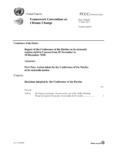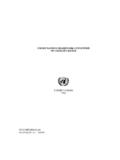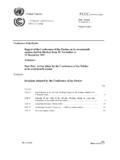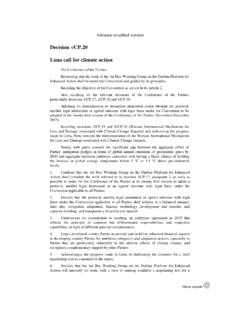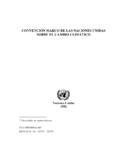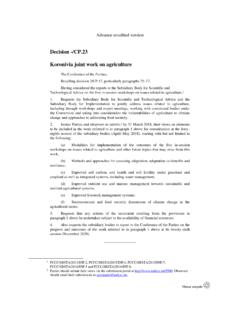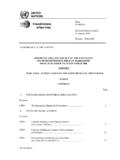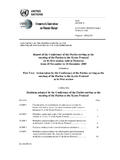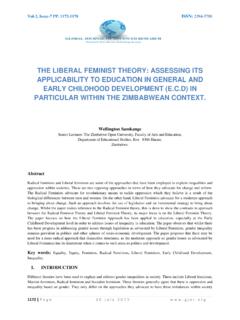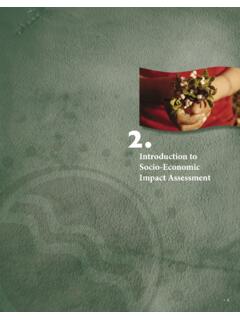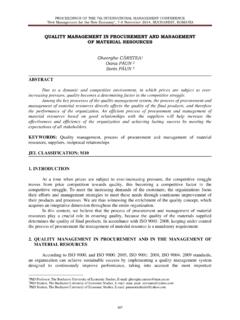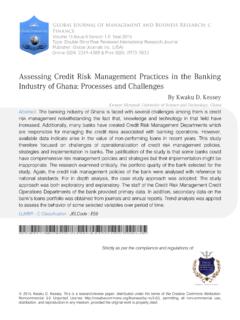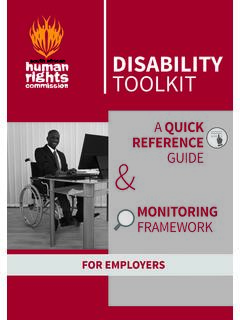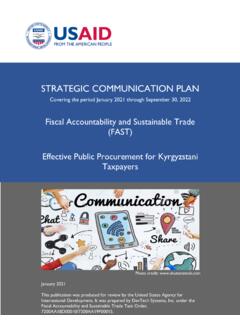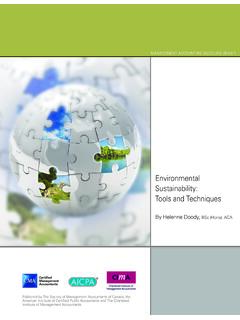Transcription of ASSESSING THE COSTS AND BENEFITS OF ADAPTATION …
1 ASSESSING THE COSTS AND BENEFITS OF ADAPTATION OPTIONS AN OVERVIEW OF APPROACHESTHE NAIROBI WORK PROGRAMMEON IMPACTS, VULNERABILITY AND ADAPTATION TO CLIMATE CHANGE1 ASSESSING THE COSTS AND BENEFITS OF ADAPTATION OPTIONS AN OVERVIEW OF APPROACHESTHE NAIROBI WORK PROGRAMMEON IMPACTS, VULNERABILITY AND ADAPTATION TO CLIMATE CHANGE2 Chaptername Xxxzz, Sample Text Secont Line Lorem Ipsum DoloreAssessing the COSTS and BENEFITS of ADAPTATION OptionsUnited NationsFramework Convention onClimate Change3 ASSESSING the COSTS and BENEFITS of ADAPTATION OptionsUnited NationsFramework Convention onClimate Change ACKNOWLEDGEMENTS 4 I.
2 INTrODuCTION 5 II. APPrOACHES FOr ASSESSING THE COSTS AND BENEFITS OF ADAPTATION OPTIONS 9 Overview Of Methodological Issues 9 Cost-Benefit Analysis 12 Cost-Effectiveness Analysis 22 Multi-Criteria Analysis 28 Other Assessment Approaches 37 III. BEST PrACTICES AND LESSONS LEArNED 42 IV. CONCLuSIONS 44 ANNEX I. GLOSSArY 45 ANNEX II. BIBLIOGrAPHY AND ADDITIONAL INFOrMATION 46 TABLE OF CONTENTS4 ASSESSING the COSTS and BENEFITS of ADAPTATION OptionsUnited NationsFramework Convention onClimate ChangeThis publication was prepared by the secretariat of the United Nations Framework Convention on Climate Change.
3 It builds upon a 2009 technical paper and a 2010 workshop on COSTS and BENEFITS of ADAPTATION options. The secretariat would like to express its gratitude to the many experts who have provided case studies and whose helpful comments greatly improved this publication, including Rachel Berger, Practical Action; Guy Hutton, World Health Organization; Michael Mullan, Department for Environment, Food and Rural Affairs of the UK; Don Lemmen and Gregory Richardson, Natural Resources Canada; Paula Mendes Luz, Evandro Chagas Clinical Research Institute, Brazil; Jairo Esc bar Llanos, Carlos Eduardo Ludena and colleagues, Inter-American Development Bank; Espen Ronneberg, Pacific Regional Environment Programme.
4 Serban Scrieciu and colleagues, United Nations Environment the COSTS and BENEFITS of ADAPTATION OptionsUnited NationsFramework Convention onClimate ChangeThe Nairobi work programme on impacts, vulnerability and ADAPTATION to climate change was launched by Parties to the United Nations Framework Convention on Climate Change (UNFCCC) in 2005. Its objective is to assist all Parties, in particular developing countries, including the least developed countries (LDCs) and small island developing States (SIDS) to: Improve their understanding and assessment of impacts, vulnerability and ADAPTATION ; and Make informed decisions on practical ADAPTATION actions and measures to respond to climate change on a sound scientific, technical and socioeconomic basis, taking into account current and future climate change and Parties to the UNFCCC, many intergovernmental, governmental, and non-governmental organizations, the private sector and individual experts contribute to the Nairobi work programme, including by carrying out mandated and pledged activities.
5 The Nairobi work programme plays an important role in the UNFCCC process through engaging stakeholders, catalyzing targeted action and facilitating knowledge sharing and learning on activities under the Nairobi work programme on ASSESSING the COSTS and BENEFITS of ADAPTATION include the preparation of a technical paper reviewing existing literature, submissions by Parties and relevant organizations on efforts undertaken to date, and a workshop on COSTS and BENEFITS of ADAPTATION information is available at < >.Box I-1. The Nairobi work programme on impacts, vulnerability and ADAPTATION to climate changeAs shown in the Fourth Assessment Report (AR4) of the Intergovernmental Panel on Climate Change (IPCC), the global climate is changing at rates unprecedented in recent human history and will continue to change.
6 The associated climate change impacts and risks are global in their nature, geographically diverse and are increasingly being felt and recorded across a range of regions, communities and and projected climate change will exhibit impacts on numerous systems and sectors that are essential for human livelihoods. An increasing number of countries, regions and communities are embarking on ADAPTATION activities. This strengthened demand for ADAPTATION efforts necessitates access to a range of robust and transparent assessment approaches to enable decision makers to efficiently allocate scarce resources. For ADAPTATION to be successful, it should ideally be undertaken within a comprehensive and iterative process of social, institutional and organizational learning and change.
7 ASSESSING the COSTS and BENEFITS of ADAPTATION options is an important part of this process, assisting ADAPTATION planners and practitioners to identify the most appropriate interventions for reducing vulnerability, enhancing adaptive capacity and building publication has been developed under the Nairobi work programme on impacts, vulnerability and ADAPTATION to climate change (see box I-1 below), and provides an introduction to a range of different assessment approaches and methodologies and shares best practices and lessons learned. It builds upon activities and contributions from the Nairobi work programme and its publication aims to: Elaborate on the role and purpose of ASSESSING the COSTS and BENEFITS of ADAPTATION options in the ADAPTATION process; Introduce a range of key methodological issues; Explain the most commonly used assessment approaches; Describe lessons learned and good practices; Provide a glossary of the most commonly used terms.
8 Provide a bibliography of useful resources and publication does not, however, claim to be a comprehensive assessment of all possible approaches, recommend one specific assessment technique above another even though it does illustrate the variety of approaches, including their strengths and shortcomings; nor does it provide answers as to how much ADAPTATION measures might cost but it does provide support to help choose between numerous possible options. A diverse range of case studies is presented throughout this publication to illustrate ADAPTATION assessment methods and options (see figure I-1). I. INTrODuCTION6 ASSESSING the COSTS and BENEFITS of ADAPTATION OptionsUnited NationsFramework Convention onClimate ChangeIntroductionBhut nNep lBolivi YemenBr zilC n d United Kin domNetherl ndsCook Isl ndsThe G mbi V nu tuFiji Cost Bene t An l sis Cost Effectiveness An l sis Multi-Criteri An l sis Risk-b sed AssessmentT pes of ssessment ppro chesFigure I-1.
9 Global distribution of case studiesTHE ADAPTATION PrOCESS AND THE rOLE OF ASSESSING THE COSTS AND BENEFITS OF ADAPTATION OPTIONSB efore elaborating on the different assessment approaches, this section provides an overview on the overall ADAPTATION process and the role of ASSESSING the COSTS and BENEFITS of ADAPTATION options. The ADAPTATION process can be divided into four stages: (i) assessment of impacts, vulnerability and risks; (ii) planning for ADAPTATION ; (iii) implementation of ADAPTATION measures; and (iv) monitoring and evaluation of ADAPTATION interventions (see figure I-2). The findings from stage (iv) feed back into stage (i), ensuring that ADAPTATION action is iterative and dynamic over the outset of any ADAPTATION initiative it is important for ADAPTATION planners to assess the implications of climate change for natural systems ( agricultural productivity, water supply) and human society ( human health, economic activity) to determine whether, and the extent to which, climate change will have an impact, pose a risk or even offer beneficial opportunities.
10 Questions to be addressed during the assessment of risks, impacts and vulnerability include: What are the current climate-related hazards and risks? How are they predicted to change over time? What are the current and future impacts of these climate-related hazards? How vulnerable is the natural or human system currently and what are the main determinants? What development trends and socio- economic factors will determine future vulnerability and impacts?Building upon the assessment of risks, impacts and vulnerability during stage (i), ADAPTATION planners can effectively identify ADAPTATION options in areas and sectors that are the most socio-economically important and/or most vulnerable to climate change during stage (ii).
